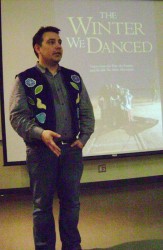Article Origin
Volume
Issue
Year
In the winter of 2012-2013, round dances erupted in malls, universities, airports, major intersections in cities and First Nations communities. Hundreds, and sometimes thousands, of Indigenous people and non-Indigenous allies joined hands to dance. That was part of the phenomenon that was called Idle No More (INM).
On April 4, a book that documents and celebrates the INM movement in writing, poetry, photographs, paintings and posters, was launched at Toronto’s Ryerson University. About 40 people attended the Canadian launch of the book entitled The Winter We Danced.
Monica McKay, director of Ryerson’s Aboriginal Initiatives and a member of the Nisga’a Nation, performed a traditional opening ceremony.
The Winter We Danced has 74 contributors. The book was the brainchild of a group called the Kino-nda-niimi Collective. Among its members are Hayden King, assistant professor of Politics and director of the Centre for Indigenous Governance at Ryerson. King is Pottawatomi and Ojibwe from Beausoleil First Nation in Ontario. Among other things, King selected the photographic images contained in the book.
Niigaanwewidam James Sinclair, who is Anishinabe from St. Peter’s Little Settlement in Manitoba, acted as the lead editor for the book. Sinclair teaches courses in Indigenous literatures, cultures and histories at the University of Manitoba.
Anishinabe Arts consultant and INM Toronto organizer, Wanda Nanibush, curated the Image Warriors section of the book, which includes paintings, prints and posters by artists such as Sonny Assu, David Garneau, LauraLee K Harris and Tannis Nielsen.
When Sinclair saw the images of the round dance at the Saskatoon Mall in December 2012, “I sat on my couch and I literally cried,” he said, knowing he was seeing something far different from what he had ever seen before. Thousands of people had gathered there for a flash mob INM round dance, and Sinclair said, “I knew this had captured the spirit and the imagination and the feelings of concern and…the desire to want to be more than things we have inherited.”
INM emerged because of three things, said Sinclair. The omnibus legislation that removed protection for the waters and put forth radical changes to the Indian Act, both of which he described as the “new removals in order to create the Northern Gateway Pipeline.” The second concern was the intense poverty manifested by Chief Theresa Spence’s hunger fast. The third problem, Sinclair said, “is the sick and violent and hierarchical relationship that this country’s built upon, which is the main problem of all. Everything else is a symptom of that relationship,” he said.
“This book,” he said, “it’s a part of this movement to say, we need to be more than we already are.”
From the first moments of the movement, Sinclair knew it had to be documented. “Those first sparks began a fire,” he said, “the fire of the beauty of expression that lived predominantly through dance was manifested in the spirits and the intention and the beauty of all of these writings that came after that…there were hundreds of pieces and tens of thousands of Tweets and status updates from Facebook and Twitter which is what largely drove the movement…”
“What this book is trying to convey,” said Sinclair, “is the fact that we have never stopped dancing. We have never been more powerful than we are now and ultimately, we have the power to control our future. And regardless of the government, change is happening… for the very first time in history, we changed the country for 15 minutes at a time.”
Sinclair said through the round dances, Indigenous people recreated what Canada has always been – a place of people, a place of relationships, a place of collaboration. That’s what they wanted to convey through the writings and the images in the book.
Hayden King said people were inspired by the photographs of the movement. “Some of the first images that came out of the movement, I couldn’t believe,” he said. “I just could not believe it.” While Indigenous peoples in Canada and North America have a long history of resistance…in my time, I’ve never seen anything like it,” he said. “I was skeptical…until I started seeing some of the images that were coming out. That really inspired me to be part of the movement, to contribute what I could of writing.”
In his presentation, King showed a photograph of what he called, “one of the most provocative protests of the movement,” the blocking of the Ambassador Bridge, the link to the U.S. in Windsor. This occurred in January 2013.
The Winter We Danced is more than 400 pages and is published by ARP Books in Winnipeg. For information on stores that carry it, their website is: www.arpbooks.org. The royalties from the sale of the book will be donated to the Native Youth Sexual Health Network www.nativeyouthsexualhealth.com
- 6994 views

